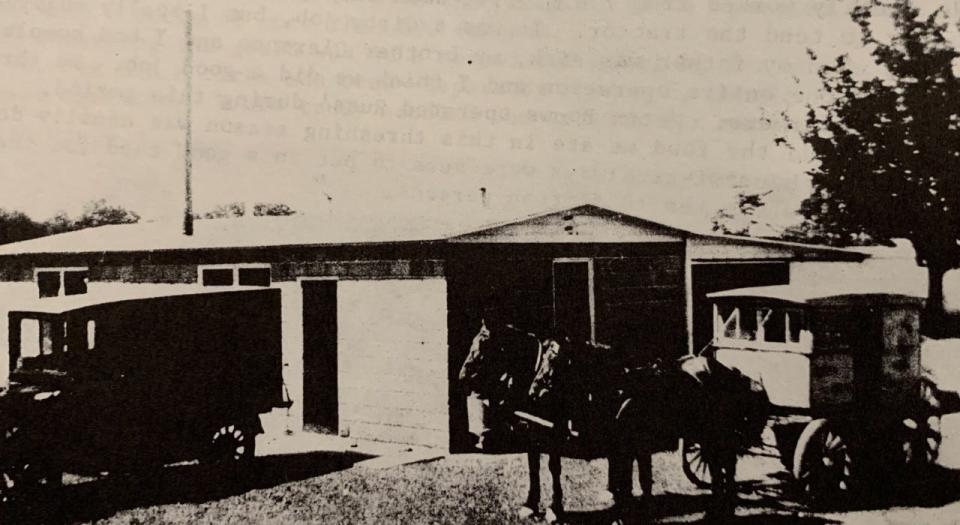Steve VanderVeen: The tale of the namesake of Russ' Restaurant, part one
Russ Bouws had farming in his blood.
His grandparents, Riekus Johannes and Zwaantje Diekovers Bouws, emigrated from Western Germany in 1847 and became one of the first settlers of Graafschap. There, they purchased and farmed 15 acres of land.
More:Russ’ Restaurant has long history on Eighth Street
In 1875, their son, John Riekus Bouws, was born, the second of sixth children. When he grew older, he married Jennie Brouwer and also farmed in Graafschap. Together, they had eight children.

By 1910, Graafschap consisted of a barbershop, a blacksmith, a carpentry, a creamery, two churches, a doctor’s house and office, a funeral home, two general stores, a hardware and implement store, a gristmill, and two schools.
Fortunately for the village, there was a good road between Holland and Graafschap, but no further. Once automobiles went down Graafschap Hill, there was no return — cars lacked the horsepower to make it up the hill and the ability to turn around in the narrow road.
Holland, meanwhile, was a much larger village. The 16th Street factories of Heinz, the Holland Shoe Company, and Holland Sugar Company anchored the city on the southwest, while the Lincoln Avenue factories of the Holland Furnace Company and Bush and Lane Piano Factory anchored it on the southeast, and Black Lake on its northwestern edge served as a gateway.
Graafschap farmers grew pickles for Heinz; beets for Holland Sugar; and strawberries, apples, cabbage, and potatoes for their neighbors, selling them door-to-door or shipping them via Black Lake and Lake Michigan to Chicago.
In 1915, a year after their sixth child, J. Russell Bouws, was born, John and Jennie decided they needed a bigger plot of land to keep farming in the family. So, they moved to an 80-acre farm in Noordeloos, two miles northwest of Zeeland.
John would wake the children at 6 a.m. After lighting the stove with kerosene and corn cobs, and firing up the furnace, he would lead the children, holding kerosene lamps and wearing wooden shoes, to the barn to milk the cows, feed the chickens, give water to the horses and clean the stables.
They would strain the milk and carry it in 10-gallon cans to the side of the road, where a dairyman in a horse-drawn wagon would pick it up. Then they would eat breakfast, consisting of corn bread and milk gravy and pork, finishing by 8:15, so the children had time to complete their a mile-and-a-half walk to school.
They would do chores again after school, stopping at 6 p.m. for supper. To supplement their food supply, a peddler came on a wagon every Friday to sell groceries.
In 1915, John bought his first automobile. In 1920, he started a threshing business and, in 1924, a milk delivery and process (dairy) business.
In the farmyard, a windmill attached to a 40-foot tower pumped water from a well into a 3,500-gallon storage tank in the barn, slightly elevated to create water pressure, which pushed the water into the house. By 1924, electricity came via a 32-volt Delco generator and 20 large storage batteries. By 1928, it came via electrical lines.

As a boy, Russ earned money by catching sparrows and trapping barn rats, for which the township treasurer paid him one cent and five cents, respectively.
One-by-one, the children moved off the farm. Russ’ oldest sister, Sue, got a job at LaHuis in Zeeland. His oldest brother, Lambertus, after graduating from the eighth grade, attended the Holland Business Institute, located above Woolworth’s in Holland at Eighth and Central.
Russ’ next oldest brother, Rich, did the same. His next oldest sister, Janice, followed in her brothers’ footsteps before finding work in the office of the Holland Furnace Company. His next oldest sister, Geneva, also worked at LaHuis. Russ’ younger brother, Clarence, attended Zeeland High School and then a college in Grand Rapids before serving in World War II.
Subscribe:Get all your breaking news and unlimited access to our local coverage
His youngest sister, Julia, left for the east coast and big city life. Russ’ youngest brother, Gord, started working with Russ when he was 12 years old, and worked with him for most of his life. He also served in World War II — and, after being wounded at Normandy, was awarded the Purple Heart.
Where did Russ and Gord work? I'll tell that story next.
— Community Columnist Steve VanderVeen is a resident of Holland. Contact him through start-upacademeinc.com.
This article originally appeared on The Holland Sentinel: Holland History: The tale of the namesake of Russ' Restaurant, part one
